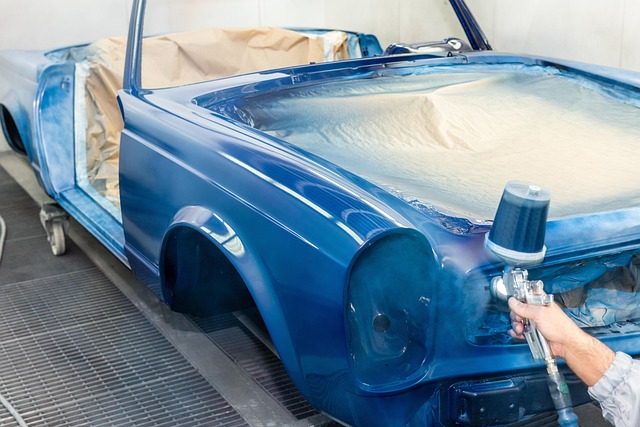Guide to Car Painting: Benefits, Longevity, and Pricing
A fresh coat of paint can transform the appearance of a vehicle, providing protection against environmental elements while enhancing its aesthetic appeal. Car painting goes beyond mere cosmetics—it serves as a protective barrier against rust, UV damage, and road debris. Whether restoring a classic car to its former glory or refreshing a daily driver's appearance, understanding the fundamentals of automotive painting can help vehicle owners make informed decisions about this significant investment.

Introduction to Car Paint Types and Their Applications
Car paint comes in several varieties, each with specific characteristics and uses. The three primary types include:
-
Acrylic lacquer: Once the standard in automotive finishing, lacquer provides a high-gloss finish but has fallen out of favor due to environmental regulations and durability concerns. It remains popular for classic car restorations where historical accuracy is valued.
-
Urethane: Currently the most common type used in professional auto body shops, urethane paints offer excellent durability, chemical resistance, and color retention. They require hardeners for proper curing and provide superior protection against UV damage.
-
Water-based paints: These environmentally friendly options have gained popularity as regulations tighten on volatile organic compounds (VOCs). They offer reduced toxicity while maintaining quality finishes comparable to solvent-based alternatives.
Single-stage paints apply color and gloss in one application, while two-stage systems use a basecoat for color followed by a clear coat for protection and shine. Modern cars predominantly use the latter for superior durability and depth of finish.
Key Features to Consider When Choosing Car Paint
When selecting paint for a vehicle, several factors warrant careful consideration to ensure optimal results and satisfaction:
Paint quality significantly impacts longevity, with premium formulations offering better UV resistance and color retention. Higher-quality paints typically contain more solids and superior pigments, resulting in better coverage and durability over time.
The intended use of the vehicle should influence paint selection. Daily drivers exposed to varied weather conditions benefit from durable urethane or ceramic-infused coatings, while show cars might prioritize depth and gloss over absolute durability.
Color choice affects more than aesthetics—some pigments naturally resist fading better than others. Metallic and pearl finishes, while visually striking, can be more challenging to match if touch-ups become necessary. Additionally, certain colors may affect resale value, with neutral tones typically maintaining broader appeal in the used car market.
Compatibility with the existing finish must be considered, as some paint types may not adhere properly to others without appropriate preparation or primer systems.
Pricing Insights on Car Paint
The cost of painting a car varies substantially based on several factors, including quality level, vehicle size, and preparation requirements.
| Quality Level | Average Cost Range | What’s Included | Typical Longevity |
|---|---|---|---|
| Economy | $500-$1,200 | Basic paint job, minimal prep work | 2-5 years |
| Standard | $1,000-$3,500 | Better paint quality, proper preparation | 5-10 years |
| Premium | $2,500-$8,000 | High-quality paint, extensive prep, clear coat | 10+ years |
| Show Car | $7,000-$20,000+ | Custom colors, multiple coats, perfect finish | 10+ years with proper care |
Prices, rates, or cost estimates mentioned in this article are based on the latest available information but may change over time. Independent research is advised before making financial decisions.
Labor typically constitutes 70-80% of total painting costs, with preparation work being the most time-consuming aspect. Proper preparation—including sanding, removing rust, repairing dents, and masking—is essential for a quality finish regardless of the paint used.
Additional factors affecting price include the number of coats applied, whether panels require removal for proper painting, and any special finishes like metallic, pearl, or color-shifting effects. Some shops charge extra for dark colors or specialty finishes that require more material or application skill.
Maintenance Tips for Car Paint
Proper maintenance significantly extends the life of automotive paint, preserving both appearance and protection. Regular washing (ideally weekly) removes contaminants that can etch or damage paint over time. Using pH-neutral car soap rather than household detergents prevents stripping of protective waxes.
Waxing or sealing the paint surface every three to four months creates a sacrificial layer that protects against environmental contaminants. Modern ceramic coatings offer extended protection periods of one to five years, though at higher initial costs.
Parking habits also affect paint longevity. Whenever possible, vehicles should be parked in garages or under covers to minimize exposure to UV rays, bird droppings, tree sap, and industrial fallout. For vehicles without garage access, a quality car cover provides significant protection.
Promptly addressing small chips and scratches prevents rust from developing and spreading beneath the paint surface. Touch-up paint can effectively manage minor damage when properly applied, while larger issues may require professional attention to prevent deterioration.
Long-Term Value of Car Painting
A professional paint job represents a significant investment that can yield substantial returns in vehicle preservation and value retention. Beyond aesthetics, a quality paint job serves as a vehicle’s first line of defense against corrosion—the primary factor in premature vehicle deterioration.
From a financial perspective, a well-executed paint job can enhance resale value, particularly for premium or classic vehicles where appearance significantly impacts market valuation. While an economy paint job may not increase value beyond its cost, a properly done mid-range or premium paint job often returns much of its value at sale time.
For classic car enthusiasts, correct paint work using period-appropriate colors and techniques can dramatically increase collectibility and value. Many restoration experts consider quality paintwork the most visible indicator of a vehicle’s overall restoration standard.
Beyond monetary considerations, many vehicle owners find satisfaction in maintaining their car’s appearance, with a fresh paint job often renewing their enjoyment of the vehicle. This psychological benefit, while difficult to quantify, represents real value for many enthusiasts who take pride in their vehicle’s presentation.
A quality paint job, when combined with proper maintenance, represents one of the most effective ways to extend a vehicle’s useful life while maintaining its aesthetic appeal and structural integrity over time.




